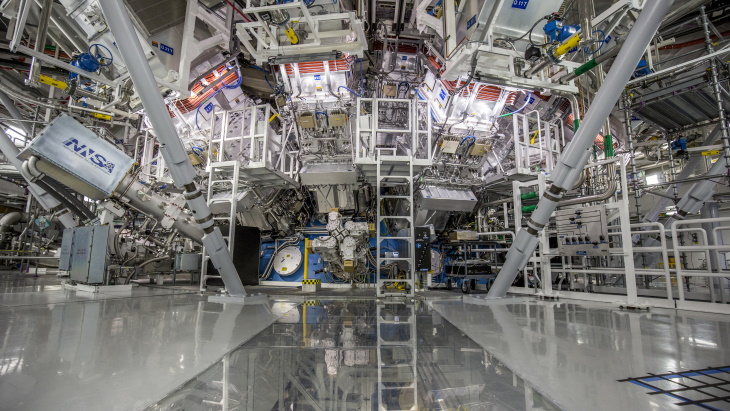The first ever controlled fusion experiment to produce more energy from fusion than the laser energy used to drive it was conducted at the National Ignition Facility (NIF) at the Lawrence Livermore National Laboratory (LLNL) on 5 December - a breakthrough that has been decades in the making.

The target chamber at NIF (Image: LLNL)
Nuclear fusion is the process by which two light nuclei combine to form a single heavier nucleus, releasing a large amount of energy. LLNL has been pursuing the use of lasers to induce fusion in a laboratory setting since the 1960s, building a series of increasingly powerful laser systems at the California lab and leading to the creation of NIF, described as the world’s largest and most energetic laser system. The facility uses powerful laser beams to create temperatures and pressures similar to those found in the cores of stars and giant planets - and inside nuclear explosions.
The 5 December experiment used 192 laser beams to deliver more than 2 million joules (MJ) of ultraviolet energy to a deuterium-tritium fuel pellet to create so-called fusion ignition - also referred to as scientific energy breakeven. In achieving an output of 3.15 MJ of fusion energy from the delivery of 2.05 MJ to the fuel target, the experiment demonstrated the fundamental science basis for inertial confinement fusion energy - or IFE - for the first time.
The achievement was announced jointly by the US Department of Energy (DOE) and the DOE National Nuclear Security Administration (NNSA).
"This is a landmark achievement for the researchers and staff at the National Ignition Facility who have dedicated their careers to seeing fusion ignition become a reality, and this milestone will undoubtedly spark even more discovery," US Secretary of Energy Jennifer Granholm said.
"This is game-changing, world-improving, lives-saving history unfolding in real time. Absolutely astonishing," she said on Twitter.
Speaking during the livestreamed announcement, NNSA Administrator Jill Hruby said the experiment marked the "first tentative steps towards a clean energy source that could revolutionise the world". As well as its potential application to provide abundant clean energy, the breakthrough will also advance nuclear security, as fusion-based laboratory experiments can help the US defence programme to maintain confidence in its deterrent without the need to perform testing, underpinning its credibility and advancing non-proliferation goals.
"The pursuit of fusion ignition in the laboratory is one of the most significant scientific challenges ever tackled by humanity, and achieving it is a triumph of science, engineering, and most of all, people," LLNL Director Kim Budil said. "Crossing this threshold is the vision that has driven 60 years of dedicated pursuit - a continual process of learning, building, expanding knowledge and capability, and then finding ways to overcome the new challenges that emerged. These are the problems that the US national laboratories were created to solve."
Inertial confinement is one of two main experimental approaches to nuclear fusion that are currently being studied. Magnetic confinement fusion uses strong magnetic fields to contain the hot plasma in a containment such as a tokamak. The US Administration earlier this year announced a "decadal vision" to accelerate fusion energy based on tokamak systems, and DOE said it is currently restarting a broad-based, coordinated IFE programme in the USA. "Combined with private-sector investment, there is a lot of momentum to drive rapid progress toward fusion commercialisation," it said.
The foundational technology for magnetic fusion is more developed than for IFE, Budil said, but NIF's achievement can be seen as "the fundamental building block" of an inertial fusion power system. "Very significant hurdles" in both science and technology remain to be overcome, but "with concerted effort a power plant could be built in a few decades", she said.
Researched and written by World Nuclear News